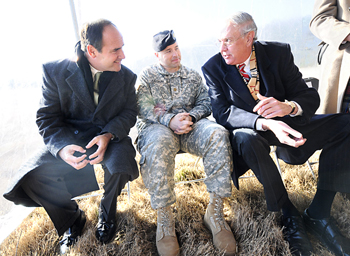 Staff Photo by Tim Barber/Chattanooga Times Free Press
Judge Neil Thomas, right, talks with Maj. William Judson, center, and Congressman Zach Wamp at Tuesday's announcement concerning the Riverbank Stabilization Construction for the Moccasin Bend National Archeological District. Maj. Judson is with the U.S. Army Corps of Engineers.
Staff Photo by Tim Barber/Chattanooga Times Free Press
Judge Neil Thomas, right, talks with Maj. William Judson, center, and Congressman Zach Wamp at Tuesday's announcement concerning the Riverbank Stabilization Construction for the Moccasin Bend National Archeological District. Maj. Judson is with the U.S. Army Corps of Engineers.With every ripple and wave, the Tennessee River scours a bit more history and dignity from the toe of Moccasin Bend and the peninsula's 12,000 years of human habitation.
But Tuesday, officials with the Chickamauga and Chattanooga National Military Park unveiled a plan to begin work in January to stabilize the riverbanks and stop the erosion.
"This is a great legacy because it's so important," said U.S. Rep. Zach Wamp, R-Tenn., about Moccasin Bend. "It sends chills up and down my spine to know that we all played a small role in making Moccasin Bend part of the national park system."
As Wamp leaves Congress in January after an unsuccessful bid for the governor's seat in Tennessee, the $3.2 million first phase of stabilization work will mark the first publicly visible sign of progress on the newest segment of the nation's oldest national military park.
Wamp, as the 3rd District congressman from Chattanooga for the past 16 years, championed the establishment of the Moccasin Bend National Archeological District as the newest unit of the nation's oldest military park, a plan finalized in 2003.
Over the past decade, he wrangled a total of more than $8.2 million for land acquisition, park and interpretive center design and about 20 percent of the needed river bank stabilization -- all expenses that go with the creation of a new park from scratch.
"Where the plains and the river and the mountains meet -- that's where people for 12,000 years have gathered," he said. "That's why it's important to preserve, protect it. ... So we've got lots of work to do."
Beating the Drum
Tuesday also marked the beginning of a two-day set of workshops among park and Friends of Moccasin Bend officials to retool themselves for the next rounds of work on planning and building the new park.
Acting park Superintendent Pat Kenney, here for three months since Shawn Benge left to become the Parks Service Southeast District superintendent, and new superintendent Cathy Cook will be at the meetings to ensure park leadership continuity. Cook is scheduled to begin work here on Jan. 5.
Wamp said federal money for the park work won't be easy to come by in today's financial climate in Washington, D.C., especially with the earmarks moratorium now being pushed in Congress.
But park advocates mustn't give up, he said.
"The political winds blow this way and that way. And the budgets go up and they come down. We have wars, and we have problems," Wamp said. "And the Congress spends its time and attention on the economy that frankly goes through cycles, too. But we can't let anything, whether it's a budget downturn or an uptick, throw us off course.
"We don't want this to be pushed down priority list," he said.
Bank work
Along Moccasin Bend's 5.4-mile perimeter, the most critical area in need of protection is the six-tenths of a mile that begins just past the toe and ends at the heel of the moccasin-shaped peninsula.
That fraction of a mile will cost $2.8 million to stabilize, said Walt Green, the stabilization project manager for the Corps of Engineers, which is partnering with the Park Service to oversee the work.
The difference between the $3.2 million allocation and the $2.8 million cost is the amount that was paid for the Bend's entire stabilization plan. It also provides a 10 percent contingency and administration fee for the National Park Service, according to Sam Weddle, park ranger and spokesman.
About half of the first work area will be covered completely with large stones known as riprap, Green said. On the other three-tenths of a mile, rock will be used to raise the bank about 31/2 feet above the normal river level.
The bank above that will be soil-filled to the top, then replanted with native grasses and trees, an effort to normalize the look of the river's edge.
Future stabilization around the perimeter of the bend will be done in five more phases -- all employing the partial riprap and partial soil approach.
The remaining work phases have not yet been funded, according to officials. In 2004, one estimate to complete the work was about $6.5 million.
Shelley Andrews, executive director of the Friends of Moccasin Bend, said public comments and Chattanooga City Council comments in the planning stages made it clear people want the park's riverbanks to appear natural, not lined with rocks.
"That was something that was said loud and clear when the project started," she said. "Make this as natural as possible."
Weddle said all the work will be done from the water, and no ground on the Bend will be disturbed.
He said the riprap is necessary to stabilize the fastest-eroding area of the bend's riverbank.
"It's the most cost-effective way to protect the resources in this most critical area, and to protect the real estate of the park there. In some places, we're losing a foot a year," he said.
Contact staff writer Pam Sohn at psohn@timesfreepress.com or 423-757-6346.